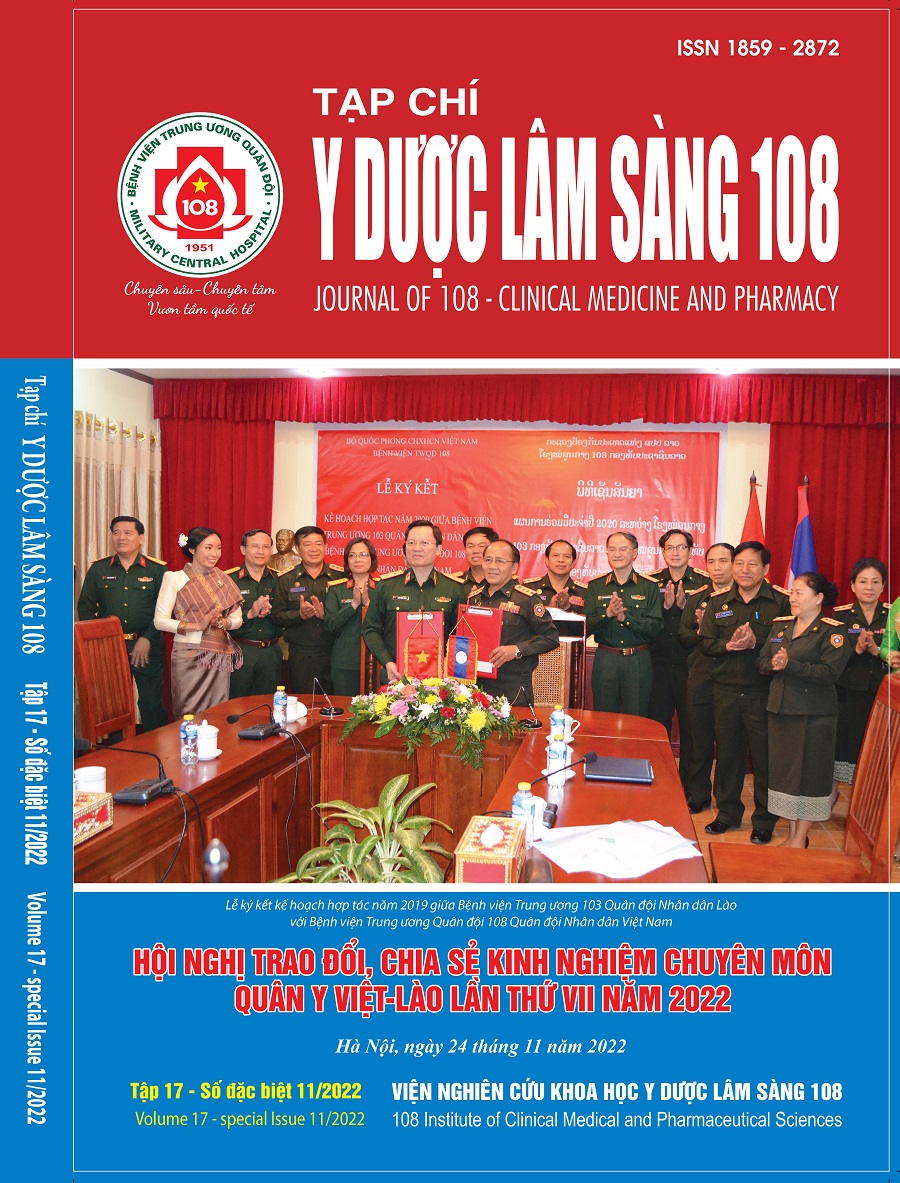Điều trị phẫu thuật kết hợp dẫn lưu não thất mở ở bệnh nhân chảy máu tiểu não lớn: Báo cáo trường hợp lâm sàng
Main Article Content
Keywords
Tóm tắt
Chảy máu tiểu não chiếm khoảng 10% trong chảy máu nội sọ, có tỷ lệ tử vong khoảng 20-75%, thường xảy ra ở người cao tuổi và có liên quan đến tăng huyết áp trong đa số các trường hợp. Khuyến cáo năm 2022 Hội Tim mạch/Hội Đột quỵ Hoa Kỳ (AHA/ASA: American Heart Assocciation/American Stroke Assocciation) cho phẫu thuật mở sọ lấy máu tụ, giải phóng chèn ép có hoặc không kèm dẫn lưu não thất ngoài đối với các trường hợp suy giảm ý thức nghiêm trọng có đè ép thân não, và/hoặc lụt não thất do tắc nghẽn, hoặc thể tích khối máu tụ tiểu não ≥ 15ml. Tuy vậy, điều trị phẫu thuật mới chỉ chứng minh được làm giảm tỷ lệ tử vong nhưng không cải thiện hồi phục thần kinh. Chúng tôi báo cáo một trường hợp chảy máu tiểu não ổ lớn, có giãn não thất được điều trị phẫu thuật mở sọ giải áp, lấy máu tụ, kết hợp dẫn lưu não thất mở (EVD: External ventricular drainage) cho kết quả hồi phục thần kinh tốt tại Bệnh viện Trung ương Quân đội 108. Mục đích của báo cáo này là nhấn mạnh việc phẫu thuật sớm và kết hợp các biện pháp điều trị để cải thiện tiên lượng hồi phục thần kinh cho bệnh nhân.
Article Details
Các tài liệu tham khảo
2. Kaufman HH (1996) Spontaneous intraparenchymal brain hemorrhage. In Wilkins RH, Rengachary SS (eds): Neurosurgery, ed 2. New York, McGraw-Hill: 2567-2585.
3. Kirollos RW, Tyagi AK, Ross SA et al (2001) Management of spontaneous cerebellar hematomas: A prospective treatment protocol. Neurosurgery 49(6): 1378-1386.
4. Auer T, Sayama I (1986) Indications for surgical treatment of cerebellar haemorrhage and infarction. Acto Neurochir (Wien) 79: 74-79.
5. Greenberg Steven M, Ziai Wendy C, Cordonnier C, et al (2022) 2022 guideline for the management of patients with spontaneous intracerebral hemorrhage: A guideline from the American Heart Association/American Stroke Association. Stroke.
6. Amar AP (2012) Controversies in the neurosurgical management of cerebellar hemorrhage and infarction. Neurosurg Focus 32(4): 1.
7. Mathew P, Teasdale G, Bannan A, et al (1995) Neurosurgical management of cerebellar haematoma and infarct. Journal of Neurology, Neurosurgery & Psychiatry 59(3): 287-292.
8. Celik SE, Uzunkol A, Sarugul B, et al (2019) Is external ventricular drainage life-saving in cerebellar hemorrhages?. Open Journal of Modern Neurosurgery 9:154-163.
9. Dahdaleh NS, Dlouhy BJ, Viljoen SV et al (2012) Clinical and radiographic predictors of neurological outcome following posterior fossa decompression for spontaneous cerebellar hemorrhage. J Clin Neurosci 19(9): 1236-1241.
10. Cohen ZR, Ram Z, Knoller N et al (2022) Management and outcome of non-traumatic cerebellar haemorrhage. Cerebrovasc Dis 14(3-4): 207-213.
11. Han J, Lee HK, Cho TG et al (2015) Management and outcome of spontaneous cerebellar hemorrhage. Journal of Cerebrovascular and Endovascular Neurosurgery 17(3): 185-193.
12. Yoshida S, Sasaki M, Oka H et al (1978) Hypertensive cerebellar hemorrhage with signs of lower brainstem compression a case report. No Shinkei Geka 6: 379-383.
13. Salvati M, Cervoni L, Raco A et al (2001) Spontaneous cerebellar hemorrhage: Clinical
remarks on 50 cases. Surg Neurol 55: 156-161.
 ISSN: 1859 - 2872
ISSN: 1859 - 2872
